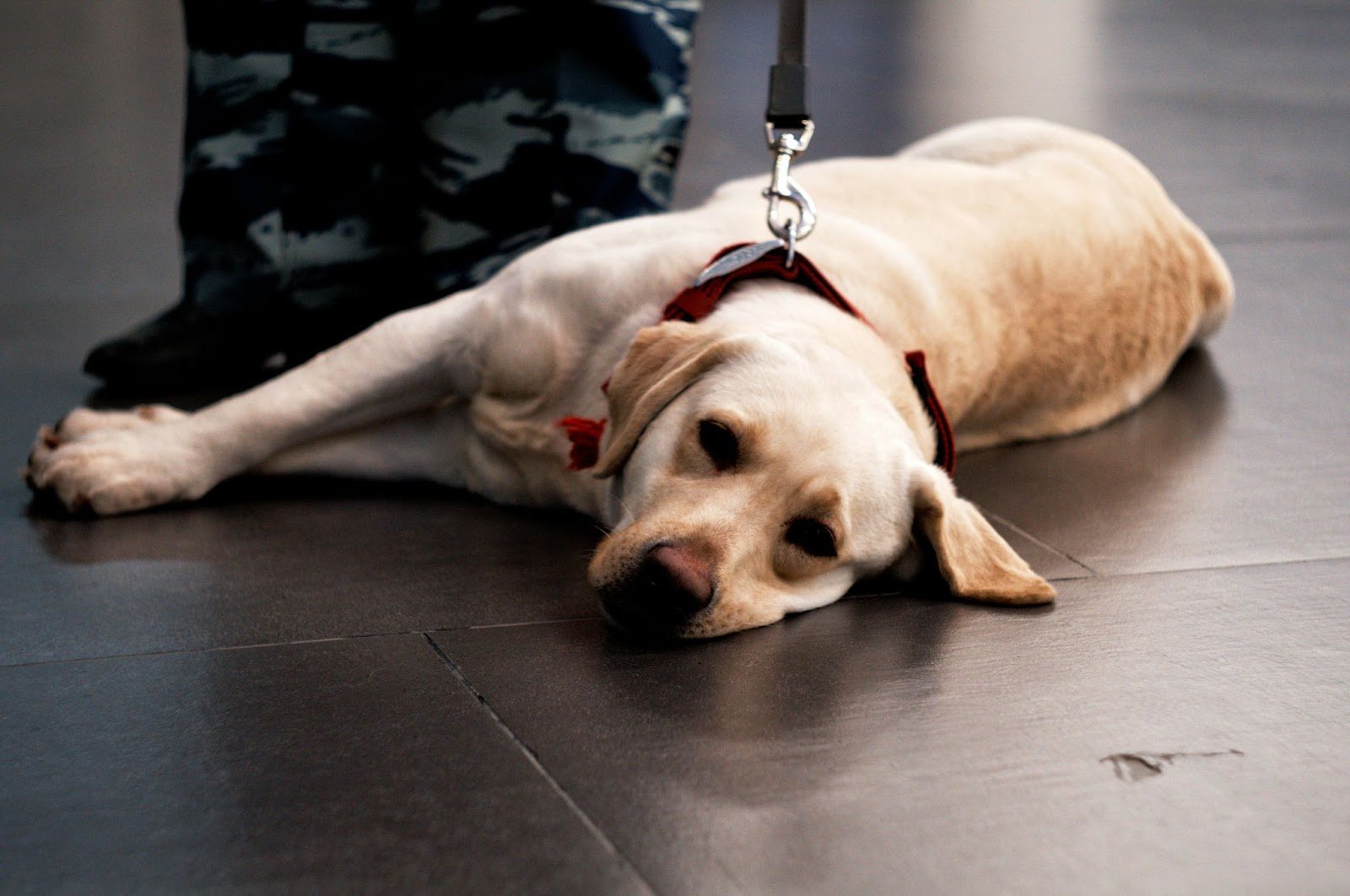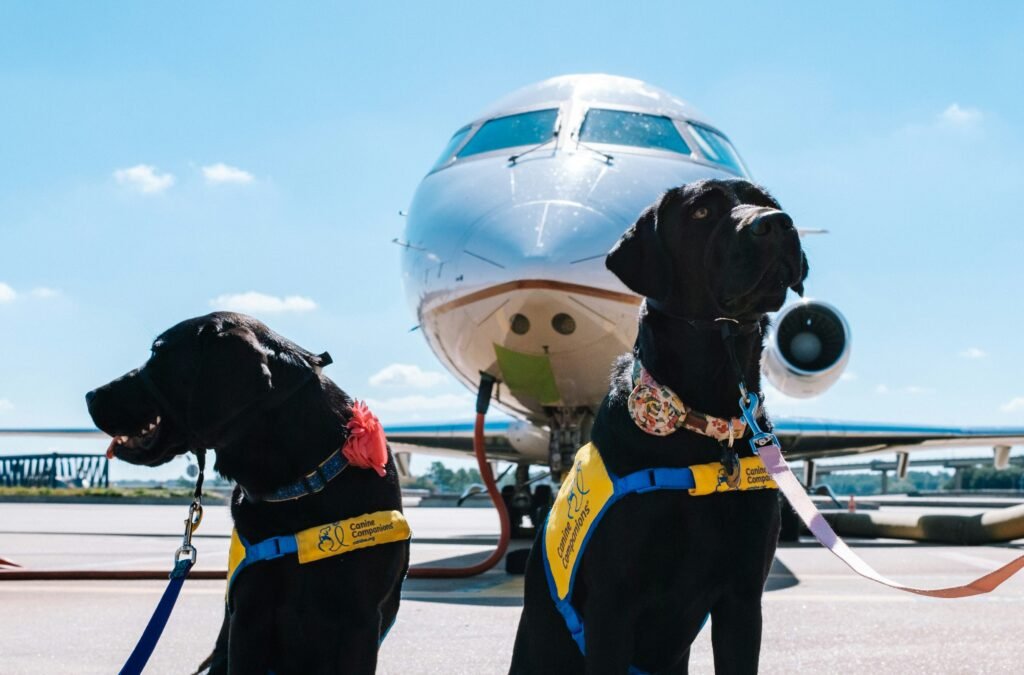Flying with a dog can be an exciting adventure, but it’s essential to be prepared to ensure a safe and comfortable journey for your pet. From understanding the rules and regulations to knowing what to bring, here’s everything you need to know about flying with a dog.
Can I Fly With a Dog on a Plane?
Flying with your dog can be a wonderful experience, but it’s important to understand the guidelines that come with it. Most airlines have specific policies regarding pets on board. This including whether they can travel in the cabin or as checked baggage. For small dogs, many airlines allow them to travel in the cabin with their owners. Airlines that allow this require that dogs are in an airline-approved carrier that fits under the seat. This option is often preferred by pet owners because it allows them to keep a close eye on their pet and ensure their comfort throughout the journey.
Many airlines will requrie larger dogs may need to travel as checked baggage. This means they will be placed in a special area of the cargo hold during the flight. While this option is generally safe, it’s important to check with the airline to ensure that they have the necessary procedures in place to accommodate your dog. Regardless of whether your dog is traveling in the cabin or as checked baggage, it’s crucial to check with the airline beforehand to understand their specific policies. This includes any paperwork or documentation that may be required, such as a health certificate from your veterinarian.

Is Flying with Dogs Stressful?
Traveling can be a stressful experience for dogs, especially if they are not accustomed to it. However, there are several strategies that can help alleviate their stress and make the journey more comfortable for them. One effective method is to use calming travel products specifically designed for dogs. These products often come in treat form, sprays, or collars that release pheromones known to have a calming effect on dogs. Calming treats are often infused with natural ingredients such as chamomile or valerian root, known for their calming properties.
Another option is to use a pheromone spray, which can be applied to your dog’s bedding or carrier before travel. These sprays mimic the natural pheromones produced by mother dogs to calm their puppies, helping to reduce anxiety during the journey. Additionally, creating a comfortable and familiar environment for your dog during travel can help reduce stress. This includes bringing their favorite toys or blankets to help them feel more secure.
Is Flying Bad for Dogs?
Flying can be a safe mode of transportation for dogs, but it’s important to take precautions to ensure their well-being. While flying itself is not inherently bad for dogs, it can be stressful and potentially dangerous. One of the most important steps you can take is to ensure that your dog is healthy and up-to-date on vaccinations before flying. This not only helps protect your dog from potential illnesses but also ensures that they are fit to travel. It’s also a good idea to consult with your veterinarian before flying. This is especially true if your dog has any underlying health conditions. Your vet can provide guidance on whether flying is safe and recommend any additional precautions you should take.
Additionally, there are several other precautions you can take to ensure their safety during the flight. This includes using an airline-approved carrier, providing them with plenty of water and bathroom breaks, and ensuring they are comfortable throughout the journey.
What Are the Rules for Flying with Dogs?
When it comes to flying with your canine companion, it’s important to be aware of the rules and regulations. While these rules can vary depending on the airline and destination, there are some common requirements that most airlines have in place to ensure the safety and well-being of pets on board. One of the most common requirements is that dogs must be transported in an airline-approved carrier. These carriers are designed to provide a safe and comfortable environment for your dog during the flight. Each of these carriers must meet specific size and ventilation requirements set by the airline.
Additionally, most airlines also require that dogs have a health certificate issued by a veterinarian. This certificate verifies that your dog is in good health and it typically needs to be issued within a certain timeframe before your departure. The specific requirements for the health certificate can vary, so it’s important to check the specific airline guidelines. Another common requirement for flying with dogs is that they must be up-to-date on vaccinations. This ensures that your dog is protected against common diseases and can help prevent the spread of illness during travel. Most airlines will require proof of vaccination, so be sure to bring along your dog’s vaccination records when you travel.
For specific rules and regulations regarding flying with dogs, it’s always best to check with the airline you’re flying with. Airlines often have their own specific policies and requirements for pet travel, so it’s important to familiarize yourself with these rules. Chewy has outlined a complete airline pet policy guide for all U.S. airlines which is a great resource for specific airline evaluations.

What Should I Bring When Flying With My Dog?
When flying with your dog, it’s essential to bring the necessary items to ensure their comfort and safety. Some essential items to pack include:
- An airline-approved dog carrier
- Food and water bowls
- Your dog’s favorite toys or blankets for comfort
- A leash and collar with identification tags
- Waste bags for cleaning up after your dog
Tips For Flying With Dogs:
Traveling with your dog can be a rewarding experience, but it requires careful planning and consideration to ensure your furry friend’s safety and comfort. Whether you’re taking a short flight or a long journey, there are several important tips to keep in mind to make the experience as smooth as possible for both you and your dog.
- Book Direct Flights: Whenever possible, book a direct flight to minimize the time your dog spends in transit.
- Visit the Vet: Before flying, visit your veterinarian to ensure your dog is healthy and up-to-date on vaccinations.
- Exercise Before the Flight: Give your dog plenty of exercise before the flight to help them relax during the journey.
- Avoid Sedation: Avoid sedating your dog unless recommended by your veterinarian, as it can be dangerous at high altitudes.
Deciding What’s Best For Your Dog:
In conclusion, flying with a dog can be a rewarding experience with proper planning and preparation. By understanding the rules and regulations, knowing what to bring, and following these tips, you can ensure a safe and comfortable journey for both you and your furry friend.

